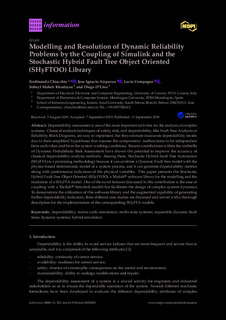| dc.rights.license | Attribution 4.0 International | * |
| dc.rights.license | Attribution 4.0 International | * |
| dc.contributor.author | Aizpurua Unanue, Jose Ignacio | |
| dc.contributor.other | Chiacchio, Ferdinando | |
| dc.contributor.other | Compagno, Lucio | |
| dc.contributor.other | Khodayee, Soheyl Moheb | |
| dc.contributor.other | D’Urso, Diego | |
| dc.date.accessioned | 2020-05-28T10:47:12Z | |
| dc.date.available | 2020-05-28T10:47:12Z | |
| dc.date.issued | 2019 | |
| dc.identifier.issn | 2078-2489 | en |
| dc.identifier.other | https://katalogoa.mondragon.edu/janium-bin/janium_login_opac.pl?find&ficha_no=154495 | en |
| dc.identifier.uri | https://hdl.handle.net/20.500.11984/1670 | |
| dc.description.abstract | Dependability assessment is one of the most important activities for the analysis of complex systems. Classical analysis techniques of safety, risk, and dependability, like Fault Tree Analysis or Reliability Block Diagrams, are easy to implement, but they estimate inaccurate dependability results due to their simplified hypotheses that assume the components’ malfunctions to be independent from each other and from the system working conditions. Recent contributions within the umbrella of Dynamic Probabilistic Risk Assessment have shown the potential to improve the accuracy of classical dependability analysis methods. Among them, Stochastic Hybrid Fault Tree Automaton (SHyFTA) is a promising methodology because it can combine a Dynamic Fault Tree model with the physics-based deterministic model of a system process, and it can generate dependability metrics along with performance indicators of the physical variables. This paper presents the Stochastic Hybrid Fault Tree Object Oriented (SHyFTOO), a Matlab® software library for the modelling and the resolution of a SHyFTA model. One of the novel features discussed in this contribution is the ease of coupling with a Matlab® Simulink model that facilitates the design of complex system dynamics. To demonstrate the utilization of this software library and the augmented capability of generating further dependability indicators, three di erent case studies are discussed and solved with a thorough description for the implementation of the corresponding SHyFTA models. | en |
| dc.language.iso | eng | en |
| dc.publisher | MDPI | en |
| dc.rights | © 2019 by the authors. Licensee MDPI, Basel, Switzerland | en |
| dc.rights.uri | http://creativecommons.org/licenses/by/4.0/ | * |
| dc.subject | Dependability | en |
| dc.subject | Monte Carlo simulation | en |
| dc.subject | Multi-state systems | en |
| dc.subject | Repairable dynamic fault | en |
| dc.subject | Trees | en |
| dc.subject | Dynamic systems | en |
| dc.subject | Hybrid simulation | en |
| dc.title | Modelling and Resolution of Dynamic Reliability Problems by the Coupling of Simulink and the Stochastic Hybrid Fault Tree Object Oriented (SHyFTOO) Library | en |
| dcterms.accessRights | http://purl.org/coar/access_right/c_abf2 | en |
| dcterms.source | Information | en |
| local.description.peerreviewed | true | en |
| local.identifier.doi | https://doi.org/10.3390/info10090283 | en |
| local.rights.publicationfee | APC | en |
| local.rights.publicationfeeamount | 935 € | en |
| local.contributor.otherinstitution | https://ror.org/03a64bh57 | en |
| local.contributor.otherinstitution | https://ror.org/01kzn7k21 | en |
| local.source.details | Vol. 10. Nº 9. 283. Published 11 September, 2019 | eu_ES |
| oaire.format.mimetype | application/pdf | |
| oaire.file | $DSPACE\assetstore | |
| oaire.resourceType | http://purl.org/coar/resource_type/c_6501 | en |
| oaire.version | http://purl.org/coar/version/c_970fb48d4fbd8a85 | en |








